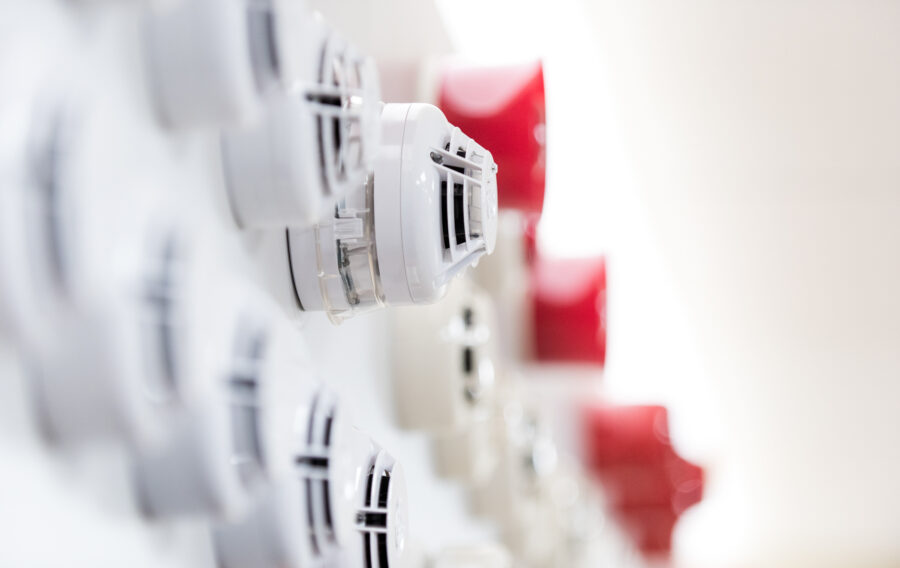Fire doors are one of the most significant fire safety features you’ll see in a building, acting as a physical barrier between fire and smoke, and those in the area. When installed, maintained and checked properly, fire doors can slow down the movement of fire and the damage it can cause.
Fire doors require regular inspection to ensure the integrity of them is intact, that they have not been vandalised or damaged and that they can perform as expected should a fire occur.
What does a fire door do?
A fire door is a specifically built piece of fire-fighting equipment, engineered to strict safety standards. When closed, such doors provide an important element of fire protection and compartmentalisation of escape routes, including stairs and corridors, protecting escape routes from the effects of fire so that occupants can reach a final exit point.
Fire doors act as passive protection in that they require no physical activation; they are effective fire resistant barriers without the need for external stimuli.
When placed at tactical locations in a building, fire doors act to divide a building into different sized compartments, also known as compartmentalisation. This decelerates the spread of fire and smoke to allow safe evacuation and reduces the risk to the rest of the building structure by containing the fire in that compartment, as well as providing valuable time for the fire rescue service to contain and put out the fire.

WHY IS IT IMPORTANT TO GET FIRE DOOR INSPECTIONS?
Ensuring fire doors are up to standard is a valuable task that should not be underestimated. In order to comply with the Regulatory Reform (Fire Safety) Order 2005, fire door installation and maintenance is a key requirement for every business to which the Order applies.

How often should fire doors be inspected?
To ensure fire doors will perform as intended in the event of a fire, regular inspections should be undertaken. Six-monthly inspections are recommended by BS 9999, consisting of extensive checks of each individual component. Inspections must be completed by a certified fire safety technician, who is able to stringently assess each of the key components for damage, faults, or wear.
If there are alterations to the fire door or its surroundings, including the frame, hinges, locks, latches or door closers, this could alter the door’s performance. If you identify any problems with your fire doors, act immediately. Do not postpone fixing issues, as this could have untold consequences should a fire occur.
Who’s in charge of fire doors?
The Responsible Person – the one (or people) who has legal responsibility for ensure the safety of a premises or event – is accountable for arranging the maintenance of fire doors. This person must ensure that regular checks of all fire doors takes place as stated in the BS9999: Fire safety in the design, management and use of buildings – Code of Practice, using a reputable company who are skilled in the importance of working with fire doors.
Learn more about the remit of the Responsible Person in our video guide.
Documenting fire door maintenance
It’s good practice to keep a maintenance log of all checks carried out on fire doors, by yourself and by competent technicians. A sufficiently documented system of regular maintenance to all elements of a fire doors is fundamental to the long-term fire safety of a building. These records should be kept up-to-date and be readily available if required.
WHAT IS COVERED DURING A FIRE DOOR INSPECTION?
Fire door inspections consist of extensive checks of each individual fire door component. Churches Fire & Security visual fire door inspections begin by focusing on the door’s structural integrity, assessing the door leaf, door frame, self-closer, door hinges, door selector, locks and handles, panic hardware, apertures and glazing.
The visual inspection also inspects passive protection features surrounding the door such as intumescent door strips and cold smoke seals. The gaps between the door and frame and the threshold gaps are measured. In addition, fire safety signage is checked for clarity and compliance, in line with current regulations.
ENSURING FIRE DOORS ARE INSTALLED CORRECTLY
Standards and regulations relate to the whole of the door installation, not simply the door itself. This includes the frame, locks, latches, hinges, door closers and all other relevant ironmongery needed to comprise the list of components to class it as a fire door.
It’s important to note that fire doors must be tested independently to British or European Standards so that in the event of a fire, they perform as required.
Churches Fire & Security works with many industries to ensure fire doors will be effective in the event of an emergency, providing servicing, maintenance and replacement with little disruption to the business day.
VISUAL INSPECTIONS
It’s important that additional weekly visual inspections are also made, to check for any potential problems.
To help with your visual inspections, you can download our FREE ten-point checklist, which gives an overview of what to consider when inspecting your company’s fire doors.
Download
If it’s been six months or more since your fire doors were last checked, or if you want to discuss fire doors and the impact they can have on your business, please contact Churches Fire & Security.
Get in touchrequest a callback
Fill out your contact details and one of our colleagues will be in touch to discuss your needs.






